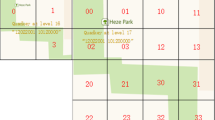Abstract
Human location prediction has been a matter of concern for several years due to its many applications. It has become more important nowadays because of prevalence of mobile devices which have adequate tools for inferring location. Different approaches for making this prediction could be divided into three categories, based on the movement history they use. These include history of mobile user himself, history of all mobile users in a place, and history of only related mobile users. Besides the problem of limiting shared data to only required data, preserving privacy is the matter of concern for persuading mobile users to share their data. In this paper we have proposed a new method in which the amount of the shared data is decreased to a minimum, and only the data which will improve the partner’s prediction will be shared. Our method preserves privacy by blurring the shared data up to different degrees. The experimental results show that regardless of amount of blurring, as long as the user movement is not lost because of blurring, the accuracy of prediction will be improved about 7 %.














Similar content being viewed by others
References
González, M. C., Hidalgo, CA, & Barabási, A.-L. (2008). Understanding individual human mobility patterns. Nature, 453(7196), 779–782. doi:10.1038/nature06958. Jun.
Shang, S., Guo, D., Liu, J., & Liu, K. (2014). Human mobility prediction and unobstructed route planning in public transport networks. In 2014 IEEE 15th international conference on mobile data management (Vol. 2, pp. 43–48). IEEE. doi:10.1109/MDM.2014.66.
Zhang, G.-A., Gu, J.-Y., Bao, Z.-H., Xu, C., & Zhang, S.-B. (2014). Joint routing and channel assignment algorithms in cognitive wireless mesh networks. Transactions on Emerging Telecommunications Technologies, 25(3), 294–307. doi:10.1002/ett.2560.
Haddadi, H., Hui, P., & Brown, I. (2010). MobiAd: Private and scalable mobile advertising. In Proceedings of the fifth ACM international workshop on mobility in the evolving internet architecture—MobiArch ’10 (pp. 33–38). New York, NY: ACM Press. doi:10.1145/1859983.1859993.
Das, B., Cook, D. J., Schmitter-Edgecombe, M., & Seelye, A. M. (2012). PUCK: An automated prompting system for smart environments: Toward achieving automated promptingchallenges involved. Personal and Ubiquitous Computing, 16(7), 859–873. doi:10.1007/s00779-011-0445-6.
Pirozmand, P., Wu, G., Jedari, B., & Xia, F. (2014). Human mobility in opportunistic networks: Characteristics, models and prediction methods. Journal of Network and Computer Applications, 42, 45–58. doi:10.1016/j.jnca.2014.03.007.
Vu, L., Do, Q., & Nahrstedt, K. (2011). Jyotish: Constructive approach for context predictions of people movement from joint Wifi/Bluetooth trace. Pervasive and Mobile Computing, 7(6), 690–704. doi:10.1016/j.pmcj.2011.07.004.
Vu, L., Nguyen, P., Nahrstedt, K., & Richerzhagen, B. (2015). Characterizing and modeling people movement from mobile phone sensing traces. Pervasive and Mobile Computing, 17, 220–235. doi:10.1016/j.pmcj.2014.12.001.
Do, T. M. T., Dousse, O., Miettinen, M., & Gatica-Perez, D. (2015). A probabilistic kernel method for human mobility prediction with smartphones. Pervasive and Mobile Computing, 20, 13–28. doi:10.1016/j.pmcj.2014.09.001.
Sullivan, B., Aiello, R., Apodaca, A., Brown, A. R. A. Llopis, J. H., & Marks, J. W. (2014). Guest movement and behavior prediction within a venue.
Do, T. M. T., & Gatica-Perez, D. (2014). Where and what: Using smartphones to predict next locations and applications in daily life. Pervasive and Mobile Computing, 12, 79–91. doi:10.1016/j.pmcj.2013.03.006.
Ang, B. K., & Daniel Dahlmeier, Z. L. J. H. M.-L. S. H. S. (2014). Indoor next location prediction with Wi-Fi. In The fourth international conference on digital information processing and communications (ICDIPC2014) (pp. 107–113).
Monreale, A., Pinelli, F., Trasarti, R., & Giannotti, F. (2009). WhereNext: A location predictor on trajectory pattern mining. In Proceedings of the 15th ACM SIGKDD international conference on knowledge discovery and data mining—KDD ’09 (p. 637). New York, NY: ACM Press. ISSN: 00221031. doi:10.1145/1557019.1557091.
Li, J., Brugere, I., Ziebart, B., Berger-Wolf, T., Crofoot, M., & Farine, D. (2015). Social information improves location prediction in the wild. In Proceedings of the 2015 international workshop on trajectory-based behaviour analytics (TrBA 15). Association for the advancement of artificial intelligence. www.aaai.org.
McInerney, J., Zheng, J., Rogers, A., & Jennings, N. R. (2013). Modelling heterogeneous location habits in human populations for location prediction under data sparsity. In Proceedings of the 2013 ACM international joint conference on pervasive and ubiquitous computing—UbiComp ’13 (p. 469). New York, NY: ACM Press. doi:10.1145/2493432.2493437.
Wen, L., Shi-xiong, X., Feng, L., & Lei, Z. (2014). Improving location prediction by exploring spatial–temporal-social ties. Mathematical Problems in Engineering, 2014(1), 1–7. doi:10.1155/2014/151803.
Xu, D., Cui, P., Zhu, W., & Yang, S. (2014). Find you from your friends: Graph-based residence location prediction for users in social media. In 2014 IEEE international conference on multimedia and expo (ICME) (No. 3, pp. 1–6). IEEE. doi:10.1109/ICME.2014.6890202.
Zhang, D., Zhang, D., Xiong, H., Yang, L. T., & Gauthier, V. (2015). NextCell: Predicting location using social interplay from cell phone traces. IEEE Transactions on Computers, 64(2), 452–463. doi:10.1109/TC.2013.223.
Greenwood, D., Sharma, S., & Johansson, A. (2015). Mobility modelling in a process constrained environment: Modelling the movements of nurses in a neonatal intensive care unit. In V. V. Kozlov, A. P. Buslaev, A. S. Bugaev, M. V. Yashina, A. Schadschneider, & M. Schreckenberg (Eds.), Traffic and granular flow ’13 (pp. 233–241). Berlin: Springer.
Chon, Y., Talipov, E., Shin, H., & Cha, H. (2014). SmartDC: Mobility prediction-based adaptive duty cycling for everyday location monitoring. IEEE Transactions on Mobile Computing, 13(3), 512–525. doi:10.1109/TMC.2013.14.
Haryanti, S. C., & Sari, R. F. (2014). Improving resource allocation performance in mobile ad hoc grid with mobility prediction. In 2014 international conference on intelligent green building and smart grid (IGBSG) (pp. 1–4). IEEE. doi:10.1109/IGBSG.2014.6835254.
Ng, M. K., & Ching, W. K. (2006). Markov chains: Models, algorithms and applications, International series in operations research and management science (Vol. 83). Boston: Kluwer.
Aharony, N., Pan, W., Ip, C., Khayal, I., & Pentland, A. (2011). Social fMRI: Investigating and shaping social mechanisms in the real world. Pervasive and Mobile Computing, 7(6), 643–659. doi:10.1016/j.pmcj.2011.09.004.
Author information
Authors and Affiliations
Corresponding author
Rights and permissions
About this article
Cite this article
Sepahkar, M., Khayyambashi, M.R. A novel collaborative approach for location prediction in mobile networks. Wireless Netw 24, 283–294 (2018). https://doi.org/10.1007/s11276-016-1304-1
Published:
Issue Date:
DOI: https://doi.org/10.1007/s11276-016-1304-1




